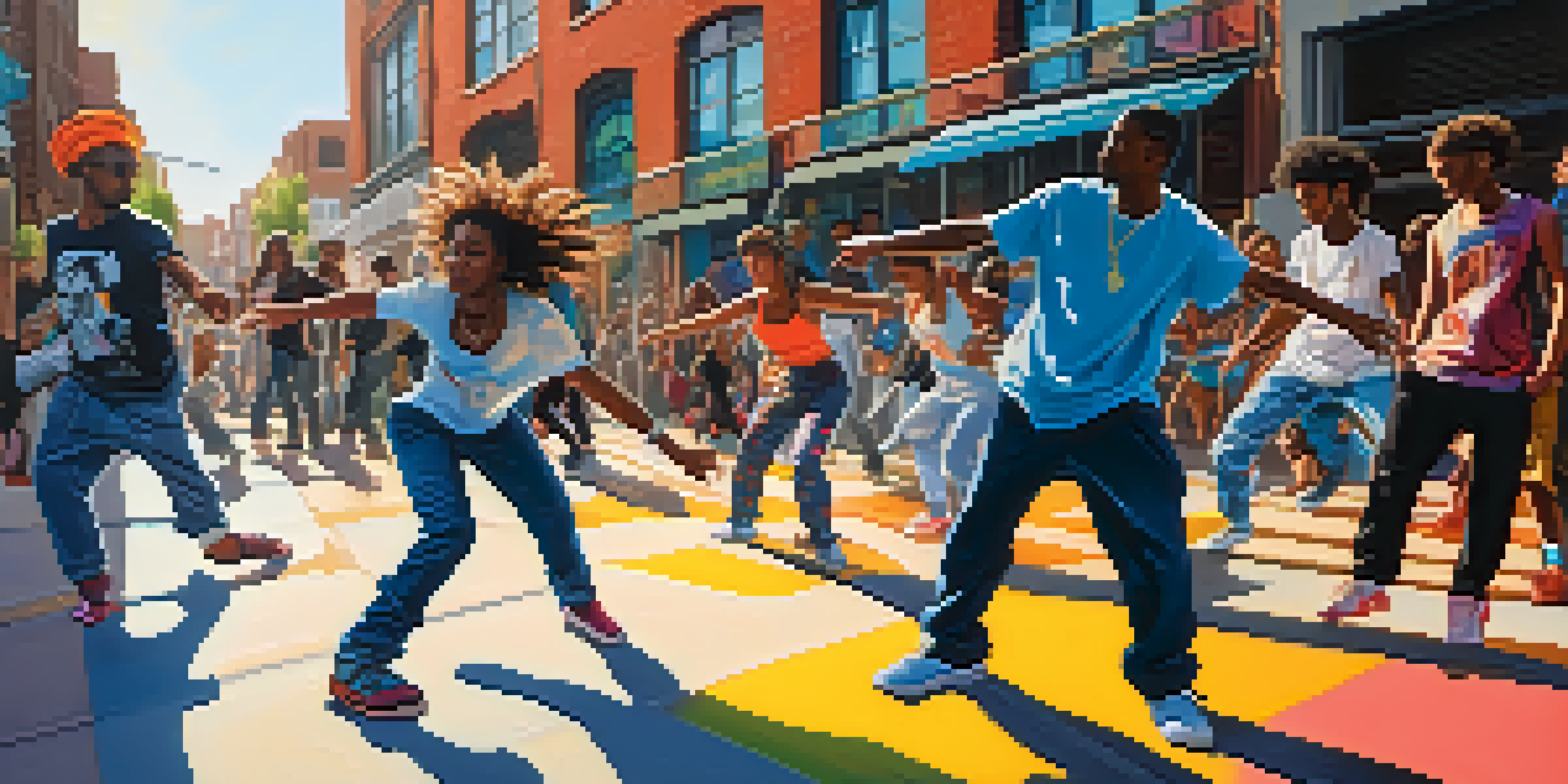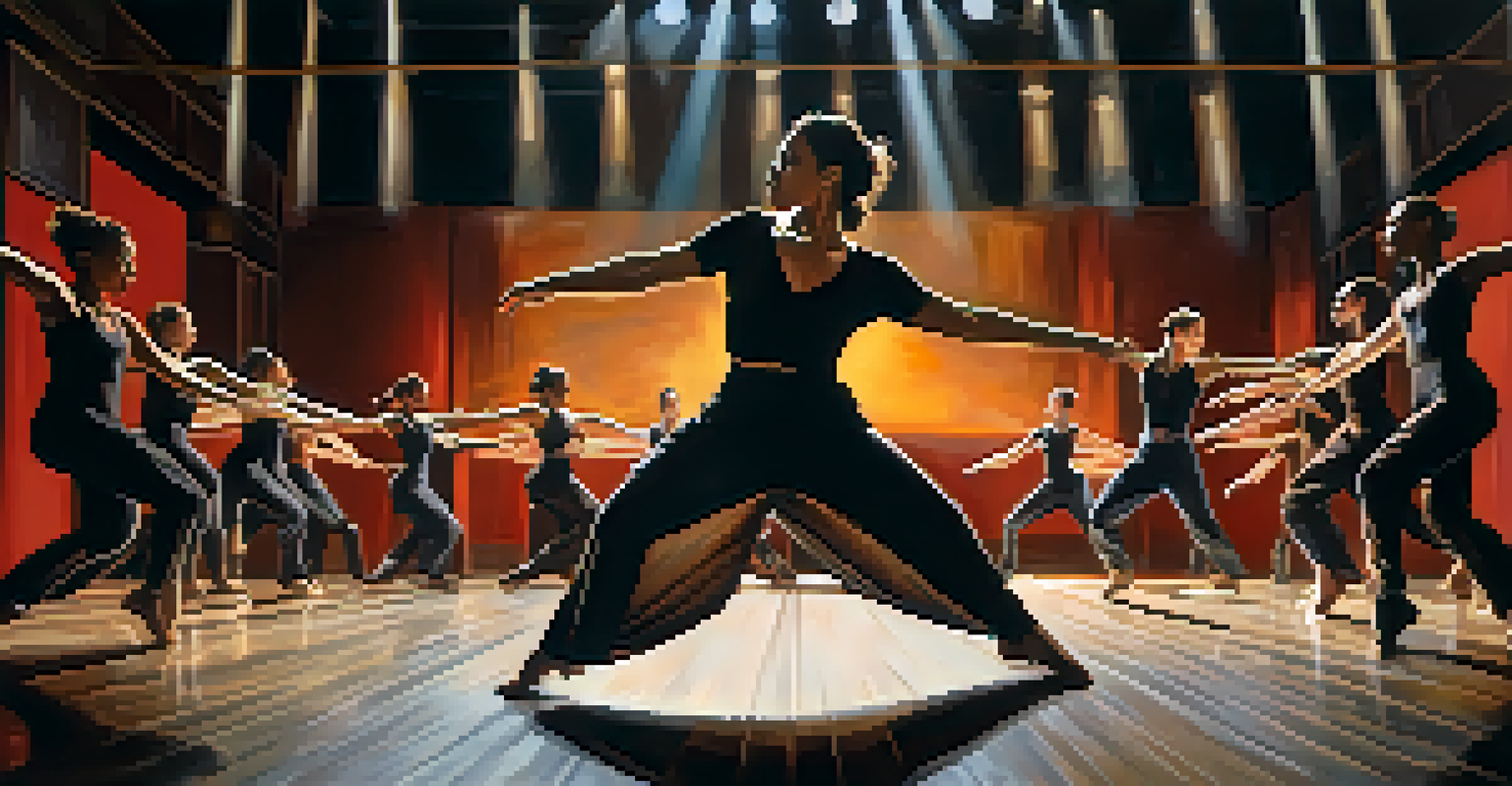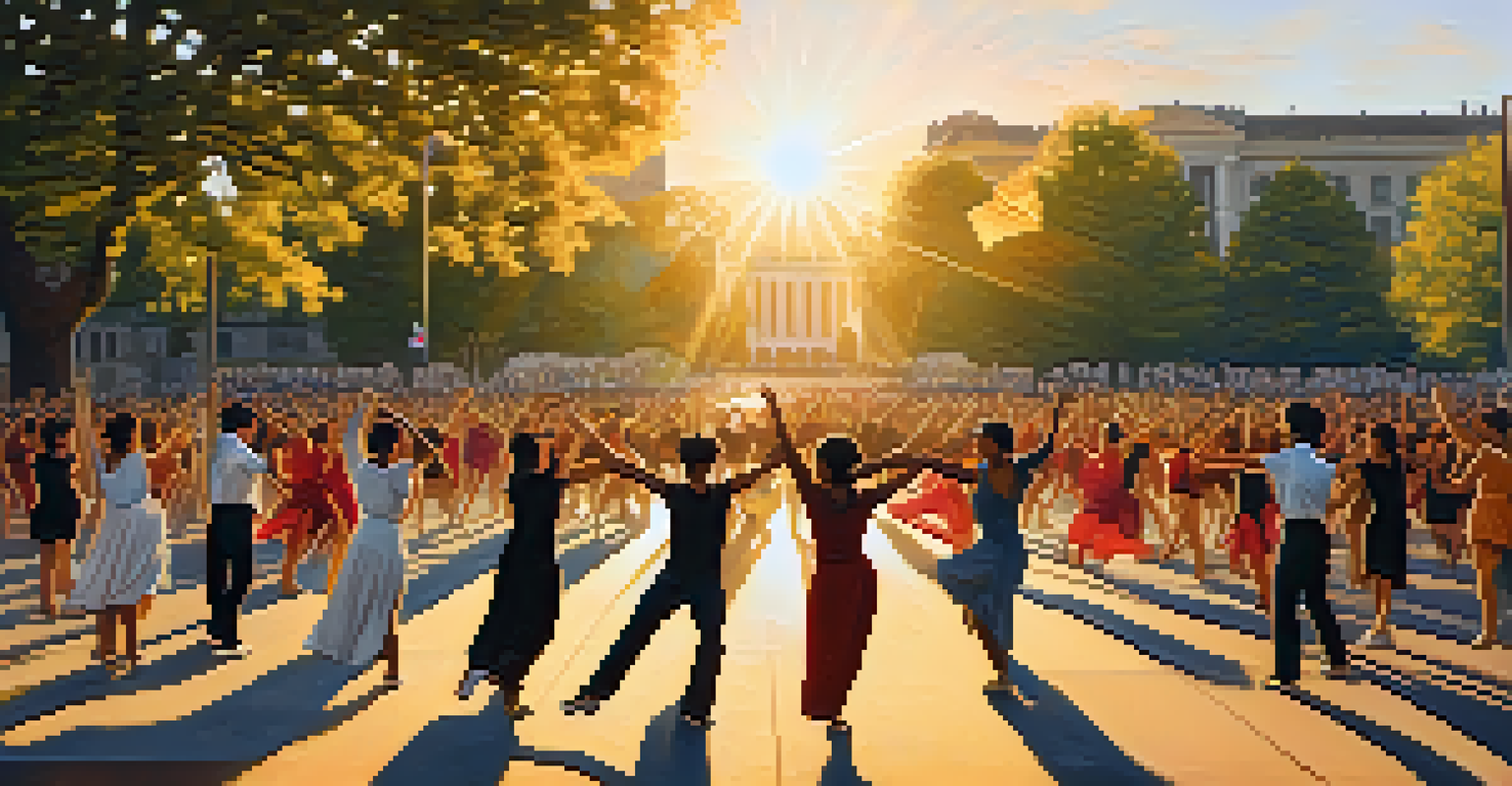The Evolution of Dance in the Context of Political Movements

The Roots of Dance as Political Expression
Dance has served as a form of expression since ancient times, often reflecting societal values and political climates. In many cultures, traditional dances were used to convey messages of resistance, unity, or cultural identity. For instance, Native American powwow dances often symbolize community strength and resilience against oppression.
Dance is the hidden language of the soul.
As societies evolved, so did the role of dance in expressing political sentiments. The emergence of folk dances in Europe during the 18th and 19th centuries often highlighted peasant struggles, serving as a voice for the marginalized. This illustrates how dance can transcend mere entertainment, morphing into a powerful tool for social commentary.
Ultimately, the roots of dance as political expression reveal its deep connection to human experience. Through rhythm and movement, dancers have historically been able to articulate hopes, dreams, and frustrations, laying the groundwork for future generations to continue this vital tradition.
Dance as a Tool for Protest in the 20th Century
The 20th century marked a significant shift in the use of dance for protest. With the rise of social movements, such as civil rights and anti-war protests, choreographers began to harness dance as a direct form of political action. Notably, Alvin Ailey’s 'Revelations' spoke to the African American experience, blending spirituality and social justice through dance.

Additionally, the feminist movement of the 1960s and 70s used dance to challenge societal norms. Women choreographers like Martha Graham and Twyla Tharp infused their works with themes of empowerment, showcasing the strength and complexity of female identity. These performances not only entertained but also provoked thought about gender roles and equality.
Dance as Political Expression
Dance has historically served as a powerful medium for expressing societal values and political sentiments.
This era solidified dance's role as a vehicle for social change, demonstrating that movement can convey powerful messages. As artists took to the stage to voice their dissent, it became clear that dance could unite people in their fight for justice, inspiring audiences to reconsider their own beliefs and actions.
Street Dance and Urban Political Movements
As we moved into the late 20th century, street dance emerged as a vibrant form of expression, often tied to urban political movements. Styles like breakdancing and hip-hop not only entertained but also provided an outlet for youth to express their frustrations with societal issues. These dance forms became synonymous with social change, highlighting themes of resistance and community solidarity.
The movement of the body is a form of expression that can convey deeper meanings than words.
For example, the 1980s saw hip-hop dance become a significant cultural force, with dancers using their skills to advocate for social justice. The culture surrounding hip-hop often engaged with themes of inequality, police brutality, and systemic racism, making it a powerful tool for political activism. Events like dance battles and competitions often served as platforms for dialogue on these pressing issues.
Through street dance, marginalized communities found a voice, reclaiming their narratives in a society that often overlooked them. This evolution illustrates how dance can adapt and respond to the socio-political landscape, enhancing its role as a form of protest and collective expression.
Global Dance Movements in the Age of Digital Activism
With the advent of the internet and social media, dance has found new platforms for political expression in the 21st century. Viral dance challenges, like the 'Harlem Shake' or 'In My Feelings' challenge, have allowed creators to infuse political messages into their movements, reaching a global audience. This digital landscape has made it easier than ever for dancers to share their stories and connect with like-minded individuals.
Moreover, movements such as Black Lives Matter have seen dance used as a form of protest. Choreography has taken to the streets, with dancers performing in solidarity to raise awareness about racial injustice and police violence. These performances not only capture attention but also foster a sense of community and urgency around the issues at hand.
Street Dance and Activism
Street dance styles like hip-hop have emerged as vital forms of protest, addressing social issues and giving voice to marginalized communities.
Digital platforms have thus redefined the evolution of dance as a political tool, amplifying voices that may have otherwise remained unheard. By merging artistry with activism, dancers today continue to shape the conversation around social change, proving that movement remains a powerful catalyst for political engagement.
Cultural Appropriation and Dance in Activism
As dance continues to evolve within political contexts, the issue of cultural appropriation has emerged as a significant concern. Many dance forms, particularly those rooted in specific cultural traditions, have been co-opted by mainstream culture without proper acknowledgment. This raises questions about ownership and respect, especially when these dances are used in political movements.
For instance, the appropriation of hip-hop dance by commercial entities often overlooks the genre's origins in marginalized communities. This can dilute the powerful messages associated with the dance form, transforming it into mere entertainment rather than a tool for activism. Such dynamics call for a critical examination of how dance is utilized within political contexts.
Addressing cultural appropriation is essential for ensuring that dance remains a genuine form of expression. By acknowledging the roots of these dances and supporting the communities from which they originate, activists can foster a more inclusive environment that respects the integrity of cultural expressions.
The Role of Choreographers in Political Movements
Choreographers play a pivotal role in shaping how dance intersects with political movements. Their creative vision often translates complex social issues into compelling performances that resonate with audiences. Figures like Pina Bausch and Bill T. Jones have explored themes of identity, race, and social justice, using choreography to provoke thought and inspire change.
Through their works, choreographers can confront societal norms and challenge audiences to reflect on their beliefs. For example, Jones’ 'Still/Here' addresses the experience of living with terminal illness, while simultaneously touching on broader themes of mortality and resilience. Such performances have the potential to spark dialogue and encourage viewers to engage with pressing social issues.
Future of Dance and Activism
The evolution of technology and social movements presents new opportunities for dance to continue as a relevant tool for political activism.
In this way, choreographers act as cultural commentators, utilizing their art to amplify marginalized voices. Their contributions to political movements underscore the importance of dance as not just an art form, but a powerful medium for social change.
The Future of Dance in Political Activism
Looking ahead, the future of dance in political activism appears promising yet complex. With the ongoing evolution of social movements and the rise of new technologies, dancers and choreographers have the opportunity to innovate and adapt their art. As issues like climate change and global inequality take center stage, dance will likely continue to serve as a medium for advocacy and expression.
Moreover, the increasing intersectionality of social movements invites diverse perspectives to the forefront. This diversity can enrich the landscape of dance, allowing for a broader range of voices and experiences to be represented. As artists collaborate across genres and cultures, dance can become an even more powerful tool for unity and understanding.

Ultimately, the future of dance in political activism hinges on its ability to remain relevant and responsive to societal changes. By embracing new forms of expression and fostering inclusivity, dance can continue to inspire action and facilitate dialogue, ensuring its place as a vital component of social movements for years to come.